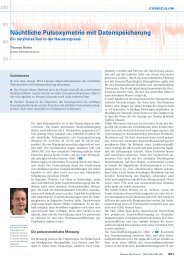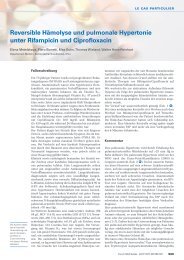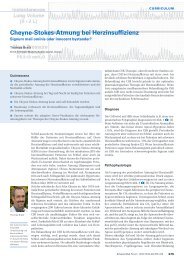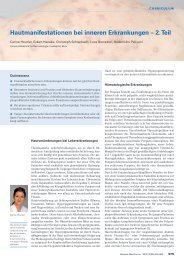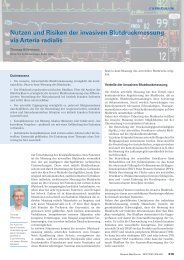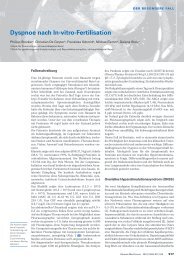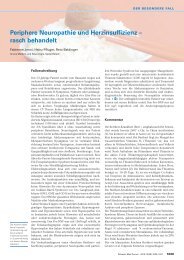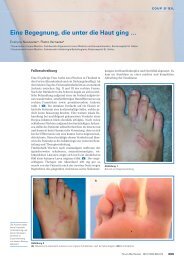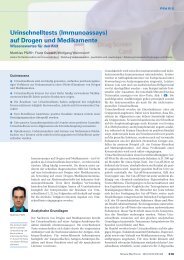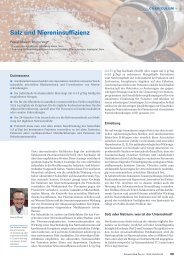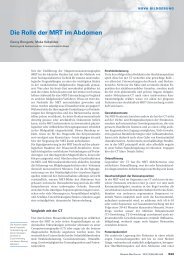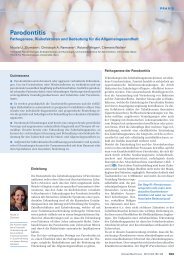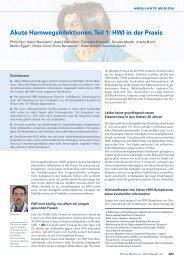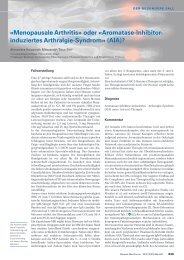Swiss Medical Forum Forum Médical Suisse
Swiss Medical Forum Forum Médical Suisse
Swiss Medical Forum Forum Médical Suisse
Create successful ePaper yourself
Turn your PDF publications into a flip-book with our unique Google optimized e-Paper software.
3.9.2008<br />
Supplementum 42<br />
ad <strong>Swiss</strong> <strong>Medical</strong> <strong>Forum</strong><br />
2008;8(36)<br />
Editores Medicorum Helveticorum<br />
Schweizerisches Medizin-<strong>Forum</strong><br />
<strong>Swiss</strong> <strong>Medical</strong> <strong>Forum</strong><br />
<strong>Forum</strong> <strong>Médical</strong> <strong>Suisse</strong><br />
Gemeinsame Jahrestagung<br />
Schweizerische Gesellschaft für Intensivmedizin (SGI)<br />
Interessengemeinschaft für Intensivpflege (IGIP)<br />
Schweizerische Gesellschaft für Pulmonale Hypertonie (SGPH)<br />
Gesellschaft für klinische Ernährung der Schweiz (GESKES)<br />
Lugano, 4.–6. 9. 2008<br />
Offizielles Fortbildungsorgan der FMH www.medicalforum.ch<br />
Organe officiel de la FMH pour la formation continue www.medicalforum.ch<br />
Bollettino ufficiale per la formazione della FMH www.medicalforum.ch
INHALT Schweiz Med <strong>Forum</strong> 2008;8(Suppl. 42) 1S<br />
C1–C5 Free communications 2 S<br />
Hot abstracts<br />
C6–C10 Free communications 4 S<br />
Session 1<br />
C11–C15 Free communications 6 S<br />
Session 2<br />
P1–P8 Posters 7 S<br />
Nutrition<br />
P9–P40 Posters 9 S<br />
Hemodynamics and inflammation<br />
IMPRESSUM Offizielles Fortbildungsorgan der Schweizerischen Gesellschaft für Innere Medizin<br />
<strong>Swiss</strong> <strong>Medical</strong> <strong>Forum</strong> –<br />
Schweizerisches Medizin-<strong>Forum</strong><br />
EMH Schweizerischer Ärzteverlag AG<br />
Farnsburgerstrasse 8, 4132 Muttenz<br />
Tel. +41 (0)61 467 85 55<br />
Fax +41 (0)61 467 85 56<br />
smf@emh.ch, www.medicalforum.ch<br />
Verlag<br />
EMH Editores Medicorum Helveticorum<br />
EMH Schweizerischer Ärzteverlag AG<br />
Postfach, 4010 Basel, www.emh.ch<br />
Redaktion<br />
Prof. Dr. Reto Krapf (Chefredaktor),<br />
Prof. Dr. Claude Genton, PD Dr. Ludwig T. Heuss,<br />
Prof. Dr. Klaus Neftel, Dr. Pierre Périat (beratender<br />
Redaktor), Prof. Dr. Ruedi Ritz (beratender<br />
Redaktor), Prof. Dr. Rolf A. Streuli, Prof. Dr.<br />
Antoine de Torrenté, Prof. Dr. Bruno Truniger,<br />
Prof. Dr. Peter Tschudi, Prof. Dr.<br />
Gérard Waeber<br />
Redaktor im Verlag<br />
Dr. Martin Sonderegger<br />
Koordination<br />
Ruth Schindler<br />
Lektorat<br />
Judith Schifferle, lic. phil. (Deutsch)<br />
Christiane Hoffmann (Französisch)<br />
Roy Turnill, MA (Englisch)<br />
Übersetzung<br />
Dr. Georges-André Berger, Dr. Rainer Bielinski,<br />
Dr. Thomas Fisch<br />
Herstellung<br />
Schwabe AG, Muttenz<br />
Zu Gunsten einer besseren Lesbarkeit wird in<br />
unseren Artikeln nur die männliche Form verwendet.<br />
Die weibliche Form ist immer mitgemeint.<br />
Inserate<br />
EMH Schweizerischer Ärzteverlag AG<br />
Ariane Furrer<br />
Assistentin Inserateregie<br />
Farnsburgerstrasse 8<br />
CH-4132 Muttenz<br />
Tel. +41 (0)61 467 85 88<br />
Fax +41 (0)61 467 85 56<br />
afurrer@emh.ch<br />
Marketing EMH<br />
Thomas Gierl M.A.<br />
Leiter Marketing und Kommunikation<br />
Farnsburgerstrasse 8<br />
CH-4132 Muttenz<br />
Tel. +41 (0)61 467 85 49<br />
Fax +41 (0)61 467 85 56<br />
tgierl@emh.ch<br />
ISSN: Printversion: 1424-3784<br />
Elektronische Ausgabe: 1424-4020<br />
Erscheint jeden Mittwoch<br />
Abonnemente FMH-Mitglieder<br />
FMH Verbindung der Schweizer Ärztinnen und Ärzte<br />
Elfenstrasse 18<br />
3000 Bern 15<br />
Tel. +41 (0)31 359 11 11<br />
Fax +41 (0)31 359 11 12<br />
fmh@hin.ch<br />
Andere Abonnemente<br />
EMH Schweizerischer Ärzteverlag AG, Abonnemente<br />
Farnsburgerstrasse 8, 4132 Muttenz<br />
Tel. +41 (0)61 467 85 75<br />
Fax +41 (0)61 467 85 76<br />
abo@emh.ch<br />
© 2008 by EMH Schweizerischer Ärzteverlag AG, Basel.<br />
Alle Rechte vorbehalten. Nachdruck, elektronische<br />
Wiedergabe und Über setzung, auch auszugsweise,<br />
nur mit schriftlicher Genehmigung des Verlages<br />
gestattet.<br />
Hinweis: Die Angaben über Dosierungsanweisungen<br />
und Applikationsformen erfolgen ausserhalb der<br />
Verantwortung von Redaktion und Verlag. Derartige<br />
Angaben sind im Einzelfall auf ihre Richtigkeit zu<br />
überprüfen.
C1<br />
Alterations in cardiac hemodynamics following endotoxin<br />
are not due to reduced myocardial contractility and decreased<br />
cardiac inotropism.<br />
L. Jianhui, F. Feihl, B. Waeber, R. Chioléro, L. Liaudet. Service de<br />
Médecine Intensive Adulte et Division de Physiopathologie Clinique,<br />
Lausanne, Switzerland<br />
Background: Impaired cardiac function due to reduced myocardial<br />
contractility is a typical manifestation of septic shock (septic cardiomyopathy),<br />
whose mechanisms remain only partly defined. Experimentally,<br />
the administration of endotoxin (lipopolysacharride, LPS) to laboratory<br />
animals is thought to reproduce many aspects of sepsis, and is therefore<br />
classically used to study the mechanisms of septic cardiomyo -<br />
pathy. However, most studies evaluating the effects of LPS on the heart<br />
in vivo have relied onto indirect, load-dependent, indices of cardiac<br />
function, and thus could not precisely determine the real consequences<br />
of LPS on cardiac contractility. Therefore, in the present study, we eva -<br />
luated the direct effects of LPS on cardiac contractility in mice, using<br />
left ventricular (LV) micro-tip pressure volume (PV) catheters, which<br />
provide load-independent measurements of cardiac function, including<br />
end-systolic elastance (Ees) and maximal elastance (Emax).<br />
Methods: Male BALB/c mice received an intraperitoneal injection of<br />
E. Coli LPS (1, 5, 10, or 20 mg/kg). After 2, 6 or 20 h, selected groups<br />
of mice were anesthetized, intubated and mechanically ventilated.<br />
A PV catheter was inserted into the LV through the right carotid<br />
artery. LV pressure (end systolic, LVSP and end-diastolic, LVDP) and<br />
volumes (end systolic, ESV and end-diastolic, EDV), were recorded,<br />
allowing the calculation of stroke volume (SV), stroke work (SW),<br />
cardiac output (CO) and ejection fraction (EF). Ees and Emax were<br />
computed from the slope of the end systolic PV relationships of<br />
successive PV loops obtained at rapidly reduced preload, by inferior<br />
vena cava compression. Mice were sacrificed at the end of experiments.<br />
Results. EDV decreased with LPS, mostly after 6 h, whereas<br />
ESV did not change. LVSP was slightly decreased only after 6 h, and<br />
LVDP was not significantly influenced by LPS. SV, SW, EF and dp/dt<br />
max were reduced at all doses of LPS, mostly after 6 h and slightly<br />
recovered after 20 h. In spite of an increase in heart rate, CO<br />
decreased, especially after 6 h and at the high doses (10 and<br />
20 mg/kg) of LPS. Most importantly, both Ees and Emax markedly<br />
increased after all doses of LPS, mostly after 2 and 6 h, and returned<br />
back to control values after 20 h. Conclusions. In striking contrast<br />
with the usual belief, LPS does not induce direct negative inotropic<br />
effects in the mouse, but instead markedly enhances contractility.<br />
The alterations in cardiac function induced by LPS are only, and<br />
entirely, due to altered loading conditions, which are mainly observed<br />
6 h after the injection of LPS.<br />
A ten year epidemiological survey of brain death in <strong>Swiss</strong> ICUs<br />
Y. Gasche 1 , A. D. Moretti 1 , R. Chioléro 2 , J.-C. Chevrolet 1 ,<br />
J.-P. Revelly 3 .<br />
1 Service de Soins Intensifs, Hôpitaux Universitaires de Genève,<br />
Genève, Switzerland; 2 Fondation suisse pour le don d’organes<br />
(FSOD), Centre Hospitalier Universitaire Vaudois, Lausanne,<br />
Switzerland; 3 Service de Médecine Intensive Adulte, Centre<br />
Hospitalier Universitaire Vaudois, Lausanne, Switzerland<br />
In Switzerland, as in the rest of Europe, the number of patients waiting<br />
for transplants largely exceeds the number of transplants performed.<br />
Compared to other European countries the donation rate in<br />
our country is dramatically low. Most organ donors are patients who<br />
die in hospital due to brain death (BD). BD has been estimated to<br />
account for 1.2, 4.3% of hospital deaths in western countries and<br />
represents approximately 13% of all deaths in ICUs.<br />
The aim of the present work was to define the epidemiology of BD<br />
in <strong>Swiss</strong> ICUs. We analysed the epidemiological data from 33 <strong>Swiss</strong><br />
ICUs, collected over a period of 10 years through the medical record<br />
review system implemented by the Donor Action Program.<br />
From 1997 to 2008 10464 patients died in the ICUs. Among them,<br />
937 patients presented all the criteria of BD (9%), but only 607 were<br />
formally diagnosed as brain dead (5.8%). The mean age of these<br />
patients was 49.8 and 57.2% were males. The most frequent admission<br />
diagnosis leading to BD was stroke (40.1%). The leading stroke<br />
pathology was subarachnoid hemorrhage (21.8%) followed by intracerebral<br />
hemorrhage (12.5%). Post-anoxic brain injury represented<br />
16.3% , while traumatic brain injury (TBI) represented only 17% of<br />
pathologies leading to BD. TBI patients from road traffic accidents<br />
represented only 5.4% of the patients.<br />
FREE COMMUNICATIONS<br />
HOT ABSTRACTS Schweiz Med <strong>Forum</strong> 2008;8:(Suppl. 42) 2S<br />
C2<br />
Brain death is an infrequent event in <strong>Swiss</strong> ICUs and is underdiagnosed.<br />
The rarity of BD suggests that only very well conducted educational<br />
programs anchored in daily practice will help to improve our<br />
diagnostic performance. Hemorrhagic stroke is the leading cause of<br />
BD in ICU patients, while TBI accounts only for a very tiny proportion<br />
of patients who will develop BD. Improvement in stroke management<br />
will probably aggravate the shortage in organ donation.<br />
C3<br />
Does extracorporeal circulation induce an increase in resting<br />
energy expenditure in critically ill children?<br />
C. Jotterand3* , J. Depeyre3 , M. O. Ranson2 , M. H. Perez1 , P. Stücki1 ,<br />
J. Cotting1 .<br />
1 Pediatric Intensive Care Unit, University Hospital, Lausanne (CHUV);<br />
2 Unit of Clinical Nutrition, University Hospital, Lausanne (CHUV);<br />
3 Dietetics, University of Applied Sciences, Geneva, Switzerland;<br />
* presenting author<br />
Introduction: In pediatric intensive care units, energy needs are<br />
complex to determine. Extracorporeal circulation (EC) that induces<br />
an inflammation could influence energy expenditure. The aim was<br />
to compare measured resting energy expenditure (REEm) with theoretical<br />
REE and energy intake (EI) in patients with (EC) and without<br />
EC (no-EC).<br />
Methods: Ventilated children with a FiO2 960% were prospectively<br />
studied. REEm was measured daily by indirect calorimetry and<br />
compared to predicted REE by the Schofield equation. EI and energy<br />
balance were calculated daily. Comparisons were tested by the t-test<br />
and the Bland-Altman method.<br />
Results: 62 children were included, 24 EC and 38 no-EC. Mean age<br />
(± SD) was 21.5 ± 20.6 months with a weight and height of 9.1 ± 4.9 kg<br />
and 75.5 ± 19.7 cm, respectively. On day 1, CRP was 110.5 ± 65.<br />
1 mg/dl in EC and 78.8 ± 87.7 mg/dl (ns) in no-EC. 337 measurements<br />
were performed. REEm was 57.9 ± 12.3 kcal/kg/d in EC and<br />
53.7 ± 10.8 kcal/kg/d in no-EC (p 10% of predicted REE). Schofield predicts accurately REE.<br />
The energy balance remains negative longer in patients with EC.<br />
C4<br />
Pulmonary Hypertension (PH) associated<br />
with myeloproliferative diseases. A study of four cases<br />
G. Paratte, G. Domenighetti, H. Stricker. Regional Hospital; Service<br />
of Pneumology and Angiology, 6600 Locarno, Switzerland<br />
Background: Few case reports and small series have demonstrated<br />
an association between PH and myeloproliferative disorders (MPD);<br />
a recent study describes two distinct forms of PH in the context of<br />
MPD, CTEPH and classical pulmonary arterial hypertension (PAH).<br />
Objectives: To illustrate the clinical and haemodynamic characteristics<br />
of PH associated with MPD in 4 patients (pts), 3 females and<br />
1 male (71 ± 13 yrs; range: 55–83 yrs), followed between 2001 and<br />
2008.<br />
Methods: Baseline evaluation was accomplished by echocardio -<br />
graphy (echo), 6’walking test (6’WT), V/Q scan, CT-angioscan and,<br />
in all but one pt, pulmonary artery catheter (PAC). Follow-up was<br />
established by echo and 6’WT.<br />
Results: Two pts had polycythemia vera (PV); a chronic myeloid<br />
leukemia (CML) and an essential thrombocythemia (ET) were diagnosed<br />
in the 2 remaining pts. At baseline, before treatment, echo-measured<br />
peak PAPsyst was 73 ± 19 mm Hg; invasively measured mean PAP<br />
was 42 ± 11 mm Hg, CI 2.30 L/min/m2 , PVR 528 ± 289 dyn.sec.cm-5<br />
and SvO2 58 ± 10. Mean 6’WT at baseline was 321 ± 20 m and NYHA<br />
functional state was III in all pts. At follow-up after a median time of<br />
49 months, echo peak PAPsyst was 62 ± 26 mm Hg (p = 0.03) and<br />
6’WT was 323 ± 160 m (p = 0.9). Treatment was based on ACO,<br />
sildenafil and bosentan. In 2 pts, (CML and ET) the cytoreductive<br />
treatment (desatinib, litalir) strongly appeared to exert an improvement,<br />
respectively a reversibility affect on PH. In only one pt, a<br />
CTEPH was suspected as the prominent form of PH. After a median<br />
of 49 months after PH diagnosis, all pts are alive.
Conclusions: Progressively increasing dyspnea in a patient with MPD<br />
warrants further investigations to rule out PH. In spite of historically<br />
reported dismal prognoses in these pts with PH, the combination<br />
between specific PH therapies and cytoreductive drugs may show<br />
unexpected benefits. In this perspective, a multinational registry of<br />
these rare conditions is strongly justified.<br />
C5<br />
Impact of an Education Program aimed to reduce the occurrence<br />
of Ventilator-Associated Pneumonia (VAP)<br />
G. Tonetti, Ch. Bomio, P.-M. Mazza, G. Domenighetti, The ICU nurse<br />
team. Intensive Care Unit, Regional Hospital, 6600 Locarno,<br />
Switzerland<br />
Background: Multiple authorities have proposed ventilator-asso -<br />
ciated pneumonia (VAP) as a quality-of-care indicator in the ICU,<br />
because it is a common, morbid and expensive hospital-acquired<br />
infection (1). Evidence shows that implementing preventive measures<br />
may reduce the incidence rate of the disease.<br />
Objective: to determine whether an education initiative (nursing and<br />
medical) could decrease the crude rate of VAP during a 3-years<br />
FREE COMMUNICATIONS<br />
HOT ABSTRACTS Schweiz Med <strong>Forum</strong> 2008;8:(Suppl. 42) 3S<br />
observation period in a 7-bed multidisciplinary ICU (2007:<br />
695 patients admitted; 2142 patients-days; 1274 ventilator days).<br />
Methods: An education program directed toward ICU nurses and<br />
doctors was developed by a ad hoc team to highlight evidencebased<br />
practices for the prevention of VAP. After this phase, VAP was<br />
tracked from April 2004 (official publication of an internal guideline<br />
protocol dealing with the nursing and medical prevention) to March<br />
2007. VAP was defined according to the criteria of ATS statement<br />
guidelines (2). Rates of VAP per 1000 ventilator-days (VD) were calculated<br />
pre- and post-protocol implementation for all patients ventilated<br />
more than 48 hrs, with early and late-onset VAP, even considering<br />
more than one VAP episode for the same patient.<br />
Results: The crude incidence rate was 15 episodes / 1000 VD in the<br />
pre-intervention period. Following implementation, the VAP crude<br />
incidence rate decreased to 4 per 1000 VA after 2 years (p = 0.04),<br />
corresponding to a relative reduction in rate of 73%.<br />
Conclusions: A focused education intervention can decrease the<br />
crude incidence of this hospital-acquired infection. However, considering<br />
the notoriously difficult clinical diagnosis of ventilator-associated<br />
pneumonia and the presence of many confounding factors in the<br />
surveillance program, this beneficial result may not necessarily represent<br />
a strong quality-of-care indicator in the intubated patient.<br />
Heyland DK et al Am J Respir Crit Care Med. 1999;159:1249–56.<br />
ATS Statement: Am J Respir Crit Care Med. 2005;171:388–416.
C6<br />
Effect of fluid management on hepatic lactate uptake in<br />
peritonitis and endotoxemia<br />
José Gorrasi1 , Hendrik Bracht1 , Sebastian Brandt2 , Lukas Bruegger3 ,<br />
Francesca Porta1 , Jukka Takala1 , Stephan Jakob1 .<br />
1 Departments of Intensive Care Medicine; 2 Anesthesiology, and<br />
3 Visceral and Transplant Surgery. Bern University Hospital (Inselspital)<br />
and University of Bern, 3010 Bern, Switzerland<br />
Introduction: Hyperlactatemia during sepsis has been associated with<br />
organ dysfunction and bad outcome. The effects of sepsis model and<br />
fluid management on hepatic lactate uptake have not been studied. We<br />
hypothesized that intra-abdominal infection and low volume administration<br />
are associated with decreased hepatic lactate uptake.<br />
Material and methods: 48 anesthetized pigs were randomly<br />
assigned to endotoxin infusion (E, n = 16), fecal peritonitis (P, n = 16),<br />
or placebo (C, n = 16), and each group further to either high<br />
(H, 20 mL/kg bwt, n = 8) or moderate (M, 10 mL/kg bwt, n = 8)<br />
fluid resuscitation for 24 hours or until death, if earlier.<br />
Systemic (thermodilution) and regional (ultrasound transit time) blood<br />
flows and lactate concentrations were measured, and hepatic lactate<br />
uptake and extraction calculated. Effects of sepsis model and fluid<br />
FREE COMMUNICATIONS<br />
SESSION 1 Schweiz Med <strong>Forum</strong> 2008;8:(Suppl. 42) 4S<br />
management were tested using ANOVA for repeated measurements.<br />
Baseline and end values were compared with Wilcoxon test.<br />
Results: Mortality was 0% in CM, 11% in CH, 13% in EM, 75% in<br />
EH, 57% in PM, and 86% in PH. Cardiac output increased in CM<br />
from 90 ± 14 mL/kg/min to 103 ± 24 mL/kg/min, in CH from 75 ±<br />
14 to 113 ± 34 (p = 0.023), in EM from 87± 17 mL/kg/min to 108 ±<br />
23 mL/kg/min (p = 0.016), in EH from 73± 22 mL/kg/min to 104 ±<br />
19 mL/kg/min (p = 0.043), in PM from 91 ± 17 mL/kg/min to 121 ±<br />
29 mL/kg/min, in PH from 85 ±16 mL/kg/min to 140 ± 70 mL/kg/min<br />
(p = 0.031).<br />
Hepatic artery blood flows were not different between groups.<br />
Hepatic lactate uptake and extraction are indicated in the table.<br />
Conclusions: While the absolute hepatic lactate uptake was maintained<br />
in all groups, animals receiving high volume resuscitation<br />
were not able to compensate increased hepatic lactate influx by<br />
maintaining hepatic lactate extraction. In both sepsis groups, high<br />
volume administration was associated with increased mortality.<br />
Grant Acknowledgement<br />
Supported by grant 3200BO/102268 from the <strong>Swiss</strong> National Fund.<br />
Table Lactate handling<br />
time CM CH EM EH PM PH<br />
hepatic lactate uptake baseline 9 ± 4 11 ± 4 12 ± 5 13 ± 5 9 ± 5 12 ± 7<br />
6h 13 ± 7 11 ± 3 15 ± 6 12 ± 4 18 ± 6 15 ± 5<br />
12 hours 11 ± 5 11 ± 3 15 ± 4 10 ± 6 17 ± 8 17 ± 7<br />
end 11 ± 4 9 ± 8 15 ± 5 14 ± 9 21 ± 15 18 ± 13<br />
% hepatic lactate extraction * baseline 54 ± 17 68 ± 11 63 ± 9 60 ± 16 47 ± 20 58 ± 19<br />
6h 60 ± 11 56 ± 7 58 ± 9 43 ± 11 45 ± 18 57 ± 16<br />
12 hours# 57 ± 12 49 ± 11 59 ± 11 28 ± 16à 42 ± 19 49 ± 19<br />
end 51 ± 8 41 ± 31& 57 ± 11 40 ± 16& 36 ± 22 39 ± 22&<br />
* time group interaction p
pathway (incl. phosphodiesterase, PP-1, SERCA). Microscopy at 24h<br />
revealed mitochondrial damage, but no gross structural changes.<br />
Conclusion: Cardiac dysfunction was present as early as 6h, and the<br />
degree of dysfunction was associated with an increased risk of mortality.<br />
A gene expression analysis of heart tissue identified prognostically<br />
relevant signaling pathways.<br />
C9<br />
Passive leg raising did not predict fluid responsiveness in<br />
hemodynamically unstable medical ICU patients<br />
A. Klarer, A. Rudiger, F. Fontana, B. Yuen, V. Müller, V. Tempelmann,<br />
M. Maggiorini. <strong>Medical</strong> Intensive Care Unit, University Hospital,<br />
Zurich, Switzerland<br />
Objective: To investigate whether passive leg raising (PLR) can predict<br />
volume responsiveness in hemodynamically unstable critically ill<br />
medical ICU patients.<br />
FREE COMMUNICATIONS<br />
SESSION 1 Schweiz Med <strong>Forum</strong> 2008;8:(Suppl. 42) 5S<br />
Methods: Fluid responsiveness was tested in 17 consecutive<br />
patients (6 sepsis, 6 respiratory failure, 4 heart failure, 1 liver failure)<br />
with a mean arterial pressure (MAP)
C11<br />
Post-Traumatic Stress Disorder one year after ICU<br />
P. Merlani, C. Chenaud, M. Verdon, T. Perneger, B. Ricou. Geneva<br />
University Hospitals and University of Geneva, Geneva, Switzerland<br />
Introduction: Post-Traumatic Stress Disorder (PTSD) is a known complication<br />
after ICU stay, and its prevalence by self-report measure is of 5–64% of<br />
patients. Associated factors frequently reported are age, length of ICU stay,<br />
some medications and delusion memories. We sought to investigate its occurrence<br />
at 1 year after ICU, associated factors and the potential impact on QOL<br />
after ICU.<br />
Methods: Adults admitted to a surgical ICU, who stayed >36 h were included<br />
after informed consent. Variables were collected prospectively during the ICU<br />
stay and tested for association with PTSD<br />
(PCL -17 items) measured 1 year after discharge from ICU. Those factors were<br />
then assessed for potential association with QOL measures at 1 year.<br />
Results: Of 762 included patients, 642 (84%) completed the 1 year follow-up,<br />
579(76%) were alive and 547 (72%) answered the questionnaire. 64 (12%)<br />
patients presented criteria of high PTSD. In the multivariate analysis, younger<br />
age, longer ICU length of stay, bad memories of their ICU stay were associated<br />
with high PTSD as previously shown. Other factors such as lower educational<br />
status, pre-existing depression or anxiety were found to be associated with<br />
occurrence of PTSD in our study, as well as significantly lower EQ and SF-36<br />
QOL outcomes, even in physical domains,.<br />
Patients with PTSD had significantly higher consumption of sleep medication<br />
after the ICU.<br />
Conclusion: PTSD is frequent 1 year after ICU. Several risk factors have been<br />
identified. PTSD probably impacts significantly on QOL.<br />
Grants: SNSF 3200B0-100789, Käthe-Zingg-Schwichtenberg (ASSM),<br />
Soc. Acad. de Genève, Péréquation Recherche et Développement HUG<br />
C12<br />
Evaluation of the user-friendliness of new generation ICU<br />
ventilators<br />
L. Vignaux, D. Tassaux, P. Jolliet. Hôpital cantonal universitaire,<br />
Genève, Switzerland<br />
In the ICU setting, incidents are often caused by human errors, most frequently<br />
related to mechanical ventilation (1). ICU ventilators are becoming more and<br />
more sophisticated and complex, which can lead to errors, in particular in<br />
emergency situations. The aim of this study was to evaluate the user-friendliness<br />
of 7 new generation ICU venti lators.<br />
10 Physicians well trained in mechanical ventilation but without knowledge of<br />
the 7 ICU ventilators tested performed 8 timed tasks per machine. Time performances<br />
were compared between each other and with a reference time<br />
established by a trained respiratory therapist (RT). Tasks were successively:<br />
switch on the ventilator, recognize the already adjusted mode, recognize and<br />
set alarms, change mode, find the pre-oxygenation command, adjust parameters<br />
for pressure support mode, stand-by and find NIV mode. Physicians rated<br />
their subjective assessment of task difficulty on a visual analogue scale<br />
(0: very easy-10 very difficult).<br />
Results are expressed as medians and interquartile range (IQR: 25th-75th percentile).<br />
For each task physicians were slower than the RT:<br />
44 (25-89) for the most rapid, vs. 14 (5-22) for the RT. A mean of 9<br />
(7-13) failures was observed by ventilator; on 3 machines more than<br />
10 failures occurred. The most rapid task with the fewest failures was pre-oxygenation<br />
(5 (3-17)). Tasks with the most failures were adjus-ting pressure support<br />
mode and finding NIV mode. The longest task<br />
was mode recognition (106 (74-146)). The most common errors were: confusion<br />
between adjusted and measured parameters, type and level of trigger and<br />
plateau pressure assessment. Visual analogue scores ranged from 3.8 to 7.3.<br />
Physicians without prior experience with specific ICU ventilators perform poorly<br />
when confronted with specific tasks. These results suggest a need of standardization<br />
between machines and improved interface user-friendliness in the design<br />
of ICU ventilators.<br />
Giraud T, Dhainaut JF, Vaxelaire JF, Joseph T, Journois D, Bleichner G, et al.<br />
Iatrogenic complications in adult intensive care units: a prospective two-center<br />
study. Crit Care Med. 1993 Jan; 21(1):40-51.<br />
C13<br />
Impact of a multimodal and multidisciplinary strategy for<br />
weaning from mechanical ventilation (MV) in a mixed ICU<br />
J. P. Revelly, M. Prella, K. Grant, P. Maravic, M. Berger, P. Eckert, L.<br />
Liaudet, Y. A. Que, M. Oddo, J. L. Pagani, M. D. Schaller, R. Chiolero,<br />
P. Eggimann. Department of Adult Critical Care Medicine and<br />
Burn Centre, CHUV, Lausanne, Switzerland<br />
Introduction: Specific measures, such as daily interruption of sedation (DIS),<br />
and systematic spontaneous breathing trials (SBT), reduce the duration of MV<br />
in selected patients. We implemented a multimodal and multidisciplinary weaning<br />
strategy in our mixed ICU.<br />
Methods: In our ICU, a weaning strategy was buid by a multidisciplinary team.<br />
It enclosed detailed recommendations, for DIS, and SBT before extubation.<br />
FREE COMMUNICATIONS<br />
SESSION 2 Schweiz Med <strong>Forum</strong> 2008;8:(Suppl. 42) 6S<br />
Responsibilities for nurses, physicians and res-piratory physiotherapists were<br />
specified. Targeting all patients with<br />
MV >48 h, it was implemented over 6 months in 2006. It was diffused through<br />
information system and pocket cards, trained in specific workshops reinforced<br />
by bedside teaching of all healthcare workers. For each patient, the potential for<br />
a weaning trial was checked daily and written in a structured section of the<br />
order sheet. Using a “before-after” design, we compared the duration of invasive<br />
MV<br />
(log-rank test), and the rate of reintubation (chi-square) during 15 months<br />
before, and after strategy implementation. Tracheostomized patients and those<br />
on MV during the implementation were excluded.<br />
Results: Of 7400 ICU stays (Jan. 2005 to Dec. 2007), 3838 episodes of invasive<br />
MV were considered, including 1755 >48h. The underlying characteristics of the<br />
patients did not change over this period. The median (quartiles) duration of MV<br />
decreased from 3.6 days<br />
(1.9–6.9) before to 3.0 (1.8–6.1) after (p
Prevalence and predictors of malnutrition in a general<br />
internal hospital caucasian population<br />
Samuel Iff 1 , Josef Aschwanden 2 , Jean-Pierre Gutzwiller 1 ,<br />
Michèle Leuenberger 1 , Martin Perrig 2 , Zeno Stanga 1,2 .<br />
1 Division of Endocrinology, Diabetes and Clinical Nutrition and<br />
2 Department of General Internal Medicine, Bern University Hospital<br />
and University of Bern, Switzerland<br />
Background: Protein-energy malnutrition (PEM) in a hospital setting<br />
continues to be an important condition affecting clinical outcome. Identifying<br />
patients at risk is the first step in its treatment. Rapid and simple<br />
identification of PEM and effective management are essential. The aim of<br />
the study was to investigate whether there are clinical predictors that can<br />
quickly identify malnourished patients at hospital admission.<br />
Methods: One hundred and one patients consecutively admitted to the<br />
general medical wards were enrolled. Current medical conditions, symptoms,<br />
participant history, eating and drinking habits, diagnoses, laboratory<br />
findings, drugs and anthropometrics were recorded. As a screening instrument<br />
to identify the risk of PEM we used the Nutrition Risk Score 2002<br />
(NRS 2002) introduced by Kondrup et al.<br />
Results: Forty-eight percent of the patients had a high risk of PEM<br />
according to the NRS 2002. Predictors for PEM were low serum albumin,<br />
drugs at risk, supplementation of micronutrients, as well as immobility,<br />
constipation and low muscle mass represented by mid-arm muscle area.<br />
The use of metoclopramide and or corticosteroids increased the odds for<br />
PEM 15-fold (p = 0.002), immobility by 5.0 (p = 0.015) and constipation by<br />
4.5 (p = 0.013). An increased level of serum albumin reduced the odds by<br />
16.6% (p = 0.001), a high mean upper-arm muscle area by 35% (p
Un protocole de nutrition suffit-il à garantir des pratiques<br />
“evidence based” (EBM)? – réalité clinique et propositions<br />
C. Longchamp 1 , R.L. Chiolero 1 , P. Coti Bertrand 2 , C. Joseph 1 ,<br />
M.M. Berger 1 .<br />
1 Service de Médecine Intensive Adulte (SMIA), CHUV, Lausanne,<br />
2 Unité de Nutrition Clinique, CHUV, Lausanne<br />
Le support nutritionnel en soins intensifs est désormais basé sur des<br />
études de niveau A et B. La participation du SMIA au «Nutrition Day 2008»<br />
avait mis en évidence des déviations par rapport aux recommandations.<br />
Cette étude a pour objectif de réaliser une analyse approfondie sur un<br />
mois.<br />
Méthodes: Analyse des patients sortis ayant séjourné plus de 3 jours en<br />
mars 2008 dans un service de 32 lits bénéficiant d’une diététicienne à<br />
60% et du Protocole NUTSIA depuis 2006. Extraction de la database:<br />
variables démographiques, nutrition risk score (NRS), jours de démarrage<br />
et voie de nutrition, bilan calorique cumulé.<br />
Résultats: 69 patients âgés de 60 ± 17 ans ont séjourné 9 ± 10 jours. Le<br />
NRS est réalisé tardivement dans 29% des cas. A 48h, le support nutritionnel<br />
est défini chez 67% des patients avec 43% de nutrition artificielle,<br />
une prédominance de NE (73%) sur PN (27%). Seuls 3 patients ont un<br />
bilan cumulé < -10000 kcal. La couverture des séjours par la diététicienne<br />
est de 50%.<br />
Conclusion: Comparé à l’EBM, les pratiques nutritionnelles sont globalement<br />
satisfaisantes, mais l’évaluation systématique est insuffisante. L’introduction<br />
de la NE est tardive et sa progression trop lente comparé au<br />
protocole. Les remèdes proposés sont une administration de NE par<br />
défaut, une augmentation de la présence de la diététicienne et son<br />
«empowerment» sur la prescription.<br />
Hypocaloric nutrition and outcome in critically ill patients<br />
with prolonged ICU stay<br />
Samuel Iff 1 , Michèle Leuenberger 1 , Zeno Stanga 1,2 ,<br />
Stephan M. Jakob 3 .<br />
1 Division of Endocrinology, Diabetes and Clinical Nutrition and<br />
2 Department of General Internal Medicine, Bern University Hospital<br />
and University of Bern, Switzerland, 3 Department of Intensive Care<br />
Medicine, Inselspital, Bern University Hospital, and University of Bern,<br />
Switzerland<br />
Background: While implementation of protocols for nutritional support is<br />
associated with less energy deficit, the impact of hypocaloric feeding on<br />
clinical relevant outcomes is more controversial: Recent studies suggested<br />
both positive and negative effects, in patients receiving the recommended<br />
intakes. The aim of this study was to assess the incidence and<br />
magnitude of hypocaloric feeding in an ICU without explicit nutrition<br />
protocols together with standardized mortality ratios.<br />
Methods: Retrospective analysis of data from all patients staying >72 h<br />
in a mixed medical-surgical 30 bed University Hospital ICU in 2006 for<br />
maximally 50 days.<br />
Results: Data from 562 patients (medical 270, surgical 292) resulting in<br />
5043 observed days were analyzed. Length of ICU and hospital stay were<br />
9 ± 9 days and 27 ± 25 days. The age was 61 ± 16 years, the weight 77 ±<br />
17 kg, BMI 26 ± 5 kg/m 2 , and APACHE II and SAPS scores 24±8 and 50 ±<br />
17. Daily energy and protein intake were 302 ± 334 kcal and 12 ± 15 g<br />
(recommended according to ESPEN: 1549 ± 342 kcal and 114 ± 29 g).<br />
The measured ICU (14%) and hospital mortality (22%) was significantly<br />
(p 72 h acquired a substantial<br />
caloric deficit during the study period when compared to recommendations.<br />
It is mandatory to introduce a standardized feeding protocol to<br />
prevent such high caloric deficits. A prospective study is running now to<br />
improve feeding support and evaluate outcome.<br />
P5<br />
P6<br />
POSTERS<br />
NUTRITION Schweiz Med <strong>Forum</strong> 2008;8:(Suppl. 42) 8S<br />
The NRS-2002 is an excellent clinical predictor<br />
of postoperative complications in surgery of colonic cancer<br />
Samuel Iff 1 , Zeno Stanga 1,2 , Jean-Pierre Gutzwiller 1,3 , Igor Schwegler 4 ,<br />
Arlette von Holzen 4 , Rolf Schlumpf 4 , Stefan Mühlebach S 1 .<br />
1 Division of Endocrinology, Diabetes and Clinical Nutrition and<br />
2 Department of General Internal Medicine, Bern University Hospital<br />
and University of Bern, Switzerland, 3 Department of Research,<br />
University of Basel, Basel, Switzerland, 4 Department of Surgery,<br />
Kantonsspital, Aarau, Switzerland<br />
Background: Malnutrition is a well known risk factor for surgery, especially<br />
in oncology patients. Despite this knowledge, a established and<br />
easy practicable diagnostic tool to screen for patients at risk<br />
for malnutrition, as proposed by ESPEN in 2002. has not yet been validated<br />
in the high risk colorectal cancer patients with surgical treatment.<br />
Objective: The aim of the study was to investigate whether the nutrition<br />
risk score (NRS 2002) predicts postoperative complications when applied<br />
at hospital admission in patients with surgery for colorectal cancer.<br />
Methods: One hundred and eighty six patients consecutively admitted to<br />
the department of surgery of the Kantonsspital Aarau, Switzerland, were<br />
enrolled in this prospective cohort study. The NRS 2002, together with<br />
current medical findings, patient history, eating and drinking habits, diagnoses,<br />
laboratory findings, drugs, anthropometrics, tumour staging and<br />
the type of operation were recorded and checked for significance by<br />
univariate analysis and multiple logistic regression.<br />
Results: 186 patients treated between January 2003 and January 2005<br />
were included in the study upon informed consent. The prevalence of<br />
malnutrition in this population was 39%. There was a higher mortality in<br />
malnourished (= NRS 2002 03) patients (6.4 % vs. 1.6%, p = 0.08) and a<br />
higher postoperative complication rate (68.5 vs. 41.6 %, p
POSTERS<br />
HEMODYNAMICS AND INFLAMMATION Schweiz Med <strong>Forum</strong> 2008;8:(Suppl. 42) 9S<br />
PHICUSS 1: Diagnostic and therapeutic approach<br />
of <strong>Swiss</strong> ICUs to pulmonary hypertension<br />
A. Azzola 1 , A. Pagnamenta 1 , H. Rothen 1 , M. Beghetti 1 ,<br />
G. Domenighetti 1 , M. Maggiorini 1 .<br />
1 Ospedale Civico Lugano, Ospedale Beata Vergine Mendrisio,<br />
University Hospital Bern, University Hospital Geneva, Ospedale La<br />
Carità Locarno, University Hospital Zürich, Lugano, Mendrisio, Bern,<br />
Geneva, Locarno, Zürich, Switzerland<br />
Background: Pulmonary hypertension (PH) is a threatening condition<br />
of various origin commonly encountered in Intensive Care Units (ICU)<br />
patients. Despite the deleterious effects of PH in critically ill patients<br />
and the increase of both morbidity and mortality, no data investigating<br />
the general prevalence of PH in the ICU setting exist.<br />
Aim: The aim of our study is to investigate 1) the prevalence of PH of<br />
any cause in the setting of surgical, medical, paediatric or interdisciplinary<br />
ICUs of primary, secondary and tertiary <strong>Swiss</strong> hospitals; 2)<br />
the most frequent causes of PH in the ICU setting above, and 3) the<br />
diagnostic and therapeutic approach to PH by the <strong>Swiss</strong> ICU physicians.<br />
Methods: Prospective multicentric investigational study conducted<br />
september 2008 during a definite two weeks period in all participating<br />
<strong>Swiss</strong> centres. All consecutive patients admitted to ICU will be<br />
screened for presence or suspicion of PH using a specific questionnaire.<br />
Expected results: We expect an underestimation of the crude prevalence<br />
of PH in the ICU setting, which could affect further attitude of<br />
treating physicians against PH in critically ill patients. Study concept<br />
and action plan are presented.<br />
P9a<br />
PHICUSS 1: Diagnostic and therapeutic approach of <strong>Swiss</strong> ICUs<br />
to pulmonary hypertension<br />
A. Azzola 1 , A. Pagnamenta 1 , H. Rothen 1 , M. Beghetti 1 , G.<br />
Domenighetti 1 , M. Maggiorini 1 .<br />
1 Ospedale Civico Lugano, Ospedale Beata Vergine Mendrisio,<br />
University Hospital Bern, University Hospital Geneva, Ospedale<br />
La Carità Locarno, University Hospital Zürich, Lugano, Mendrisio,<br />
Bern, Geneva, Locarno, Zürich, Switzerland<br />
Background: Pulmonary hypertension (PH) is a threatening condition<br />
of various origin commonly encountered in Intensive Care Units (ICU)<br />
patients. Despite the deleterious effects of PH in critically ill patients<br />
and the increase of both morbidity and mortality, no data investigating<br />
the general prevalence of PH in the ICU setting exist. Diagnostic<br />
and therapeutic attitude of different ICUs in regards to PH varies<br />
broadly. The PHICUSS1-study (Pulmonary Hypertension in the ICU –<br />
<strong>Swiss</strong> Survey 1) investigate the prevalence of PH of any cause in<br />
the setting of surgical, medical, paediatric or interdisciplinary ICUs<br />
of primary, secondary and tertiary <strong>Swiss</strong> hospitals and the most<br />
frequent causes of PH in the ICU setting above.<br />
Aim: to assess the diagnostic and therapeutic approach to PH by the<br />
<strong>Swiss</strong> ICU physicians, in the contest of the PHICUSS-1 and before<br />
study begin.<br />
Methods: PHICUSS-1 is a prospective multicentric investigational<br />
study conducted september 2008 during a definite two weeks period<br />
in all participating <strong>Swiss</strong> centres. During spring-summer 2008 and<br />
before begin of the study we investigated the diagnostic and therapeutic<br />
approach to PH of all participating centres by a standardized<br />
questionnaire.<br />
Results: the approach of <strong>Swiss</strong> ICUs to patients with suspected or<br />
confirmed PH will be presented. We expect a broad difference in the<br />
attitude of <strong>Swiss</strong> ICUs regarding the diagnostic and therapeutic<br />
approach to PH.<br />
P10<br />
Three years’ experience in the evaluation of suspected<br />
pulmonary hypertension in a regional hospital<br />
F.S. Groebli, J-M Fellrath, R.M. Zürcher Zenklusen (Hôpital<br />
neuchâtelois Pourtalès, Neuchâtel)<br />
Introduction: Pulmonary hypertension (PH) is a very rare but life-threatening<br />
disease. Screening for PH is performed by echocardiography<br />
but definitive diagnosis requires right heart catheterization (RHC).<br />
Methods: Between July 2005 and May 2008, 20 elective RHCs were<br />
performed by internal jugular or subclavian vein puncture in<br />
P9<br />
19 patients referred due to suspected PH in steady state conditions.<br />
The patients with confirmed PH were classified according to the<br />
Venice 2003 classification 1. PH was considered mild if the mean<br />
pulmonary arterial pressure (mPAP) was 25–35 mm Hg, moderate<br />
if mPAP was 35–45 mm Hg and severe if mPAP was >45 mm Hg.<br />
If mPAP was >35 mm Hg and capillary wedge pressure was
POSTERS<br />
HEMODYNAMICS AND INFLAMMATION Schweiz Med <strong>Forum</strong> 2008;8:(Suppl. 42) 10 S<br />
Effects of hypoxia and cardiac tamponade<br />
on hepato-splanchnic blood flow distribution<br />
and ex vivo nor-epinephrine vascular reactivity<br />
José Gorrasi 1 , Francesca Porta 1 , Jukka Takala 1 , Bruno Balsiger 1 ,<br />
Sebastian Brandt 2 , Lukas Bruegger 3 , Hendrik Bracht 1 , Stephan M.<br />
Jakob 1 .<br />
1 Departments of Intensive Care Medicine, 2 Anesthesiology,<br />
and 3 Visceral and Transplant Surgery, University Hospital Bern<br />
(Inselspital), and University of Bern, 3010 Bern, Switzerland.<br />
Introduction: Low blood oxygen content and low systemic oxygen<br />
delivery trigger different systemic and regional hemodynamic<br />
responses. While the physiologic response to hypoxia is an increase<br />
in cardiac output, regional abdominal blood flow redistribution has<br />
been described in low flow states. We hypothesized that hepatosplanchnic<br />
vascular reactivity is different in these two conditions.<br />
Methods: We studied 16 anesthetized and mechanically ventilated<br />
pigs randomized to cardiac tamponade (CT, n = 8) and hypoxic<br />
hypoxia (HH,n = 8). In CT, cardiac output was reduced in 6 hr-steps<br />
to reach 50, 40 and 30 ml.kg –1 .min –1 . In HH, FiO2 was reduced in 6 hrs<br />
to reach a PaO2 of 50–60 mm Hg and then at 12 hrs to 30) were designed to<br />
receive LPS bolus (2 ng/kd) or placebo at two different sessions in<br />
a randomized order. The lapse in time between the two observations<br />
was 7–10 days. Variables: Physiological variables (Cardiac output,<br />
heart rate, blood pressure, systemic vascular resistance and tempe -<br />
rature), energy expenditure (indirect calorimetry) and blood samples<br />
(cytokines, stress hormones). Variables were measured at 30 min<br />
intervals, starting 60 min before LPS/placebo bolus till T360 min after<br />
injection. Analysis: A two sided t-test, Area under the curve (AUC).<br />
Results: Significant differences (p
POSTERS<br />
HEMODYNAMICS AND INFLAMMATION Schweiz Med <strong>Forum</strong> 2008;8:(Suppl. 42) 11 S<br />
Gram-negative bacteria. We have recently shown that MD-2 was an<br />
acute phase protein specifically binding to Gram-negative bacteria,<br />
and an opsonin mediating Gram-negative bacteria phagocytosis by<br />
neutrophils and macrophages (Tissieres et al, Blood 2008). The study<br />
of the regulatory mechanisms controlling MD-2 expression should<br />
help to understand how and why the md-2 gene is turned on in the<br />
context of the host response to bacterial infection and sepsis.<br />
Methods and results: Bioinformatic analysis of md-2 GenBank<br />
sequences, outlined three putative variants. Using RT-PCR directed<br />
screening of all putative MD-2 mRNA variants in four different human<br />
cell lines (THP-1, HL-60, HepG2, Sw620), we found only one MD-2<br />
sequence (NCBI RefSeq). Our work next focused on the identification<br />
of key regulatory elements in the human md-2 promoter (hPMD-2),<br />
responsible for basal activity of the gene and for MD-2 inducibility<br />
by IL-6, a classical cytokine driving the acute phase response.<br />
Sequential deletions of the hPMD-2 promoter driving a luciferase<br />
reporter gene were transiently transfected into HepG2 cells. Basal<br />
luciferase activity was lost after the deletion of the -186/+68 bp<br />
hPMD-2 region, suggesting that basal regulatory sites are present<br />
in this region. Cross-matched bioinformatic analysis allowed iden -<br />
tifying two consensus sequences for PU.1 binding sites. IL-6 induction<br />
of the promoter constructs was lost after deletion of the -542/<br />
-399 regions, where a CAAT/enhancer binding protein (C/EBP) b;<br />
consensus sequence or NF-IL6 binding site (-506/-512) was iden -<br />
tified. Site directed mutagenesis of both PU.1 and NF-IL6 binding<br />
sites confirmed that these sites were required for basal and IL-6induced<br />
md-2 expression. Chromatin immunoprecipitation (ChIP)<br />
experiments coupled with quantitative PCR (qPCR) confirmed that<br />
both PU.1 and C/EBP ; bound in vivo their putative regions. Interestingly,<br />
PU.1 binding was increased upon IL-6 stimulation in HepG2<br />
cells. Using qPCR, pu.1 expression was not induced in HepG2 cells<br />
stimulated by IL-6. C/EBP ; was shown to bind in the vicinity of PU.<br />
1 binding sites following IL-6 stimulation, suggesting that C/EBPb;<br />
may cooperate with PU.1. To determine whether C/EBPb; co-activate<br />
PU.1 through a cis- or and trans-activation mechanism, ChIP expe -<br />
riments were performed in HepG2 cells transiently transfected with<br />
mutated NF-IL6 hPMD-2. NF-IL6 binding site was shown to be<br />
required for C/EBPb binding to PU.1 binding sites, strongly suggesting<br />
a PU.1 and C/EBPb cooperative cis-activation of the human md-2<br />
gene.<br />
Conclusion: In this work, we have identified PU.1 as a critical regu -<br />
lator of basal human md-2 expression. C/EBPb binding to the promoter<br />
is required for MD-2 up-regulation by the acute phase inducer<br />
IL-6 cytokine, via a cis-activation implicating transcription factors<br />
cooperating at the level of PU.1 and NF-IL6 sequences of the proximal<br />
md-2 promoter region. These studies unravel a unique mechanism<br />
by which the acute phase reactant and opsonin MD-2 is regulated<br />
in hepatocytes.<br />
Prospective Study of the barriers to nutritional support<br />
in a paediatric intensive care unit<br />
*D. Egli 2 , L. Ciutto 2 , MO. Ranson 3 , J. Depeyre 2 , J. Cotting 1 .<br />
1 Paediatric Intensive Care Unit, University Hospital, Lausanne<br />
(CHUV), Switzerland; 2 Dietetics, University of Applied Sciences,<br />
Geneva, Switzerland; 3 Unit of Clinical Nutrition, University<br />
Hospital, Lausanne (CHUV), Switzerland. * presenting author<br />
Introduction and aim: Children hospitalised in a paediatric intensive<br />
care unit (PICU) are mainly fed by nutritional support (NS) which may<br />
often be interrupted. The aims of the study were to verify the relationship<br />
between prescribed (PEI) and actual energy intake (AEI) and to<br />
identify the reasons for NS interruption.<br />
Methods: Prospective study in a PICU. PEI and AEI from day 1<br />
to 15, type of NS (enteral, parenteral, mixed), position of the feeding<br />
tube, interruptions in NS and reasons for these were noted. Inter -<br />
ruptions were classified in categories of barriers and their frequency<br />
and duration were analysed.<br />
Results: Fifteen children (24 ± 25.2 months) were studied for 84 days.<br />
The NS was exclusively enteral (69%) or mixed (31%). PEI were<br />
significantly higher than AEI (54.7 ± 32.9 vs 49.2 ± 33.6 kcal/kg,<br />
p = 0.0011). AEI represented 93% of the PEI. Ninety-eight interruptions<br />
were noted and lasted 189 h, i.e. 9.4% of the evaluated time.<br />
The most frequent barriers were nursing procedures, respiratory<br />
physiotherapy and unavailability of intravenous access. The longest<br />
were caused by the necessity to stop NS for surgery or diagnostic<br />
studies, to treat burns or to carry out medical procedures.<br />
Conclusion: AEI in PICU were inferior by 7% to PEI, considerably<br />
lower than in adult studies. Making these results available to medical<br />
P16<br />
staff for greater anticipation and compensation could reduce NS<br />
interruptions. Starving protocols should be reconsidered.<br />
P17<br />
Rotation-thromboelastometry (Rotem), compared to standard<br />
coagulation parameters, did not add further information on<br />
coagulopathy of medical ICU patients<br />
K. Shaikh 1 , A. Rudiger 1 , M. Previsdomini 1 , M. Müller 1 , B. Yuen 1 ,<br />
V. Temeplmann 1 , M. Maggiorini 1 .<br />
1 <strong>Medical</strong> Intensive Care Unit, Universitiy Hospital, Zurich, Switzerland<br />
Aim: To investigate the value of Rotem compared to standard coa -<br />
gulation parameters in medical ICU patients.<br />
Method: We measured clotting time (CT), clot formation time (CFT)<br />
and maximal clot formation (MCF) and compared them with INR,<br />
aPTT, fibrinogen and platelet count in 19 patients. Rotem normal<br />
values were defined by the manufacturer. Cut-off values for the<br />
detection of a clinically relevant coagulation disorder were set for INR,<br />
aPTT, platelets and fibrinogen at 1.5, 40 sec, 50’000/ml and 1.5 g/l,<br />
respectively.<br />
Results: The best correlation was found between fibrinogen and<br />
MCF-fib-TEM (r = 0.87, p 40 sec in 2 patients. MCF-ex-TEM correlated with<br />
platelet count (r = 0.79, p 18 years,<br />
ICU stay >24 hours, and to accept hypnosis. Standardized opioid<br />
prescription with pain control objective (visual analog scale (VAS)<br />
score
POSTERS<br />
HEMODYNAMICS AND INFLAMMATION Schweiz Med <strong>Forum</strong> 2008;8:(Suppl. 42) 12 S<br />
P19<br />
Therapeutic hypothermia after cardiac arrest doubles<br />
both ventilator days and length of ICU stay<br />
Barbara Affolter, MD, Gianmarco Balestra, MD, Michael Fischer,<br />
MD, Patrick Hunziker, MD, Stephan Marsch, MD, PhD<br />
Background: In spite of substantial progress in medicine, patients<br />
suffering from sudden cardiac arrest still have an unfavourable prognosis.<br />
One of the small steps towards a better outcome was made<br />
with the data from two studies published in the year 2002 showing<br />
that mild therapeutic hypothermia improves the outcome after cardiac<br />
arrest. Mild hypothermia is recommended in the 2005 guidelines<br />
of cardiopulmonary resuscitation. In our institution mild therapeutic<br />
hypothermia is standard therapy for survivors of cardiac arrest with<br />
ventricular fibrillation being the first recorded rhythm since the middle<br />
of 2005. The aim of the present study was to assess the impact of<br />
this new therapy concept on resources in intensive care.<br />
Methods: The study was conducted in a medical intensive care unit<br />
of an university hospital. We compared prospectively sampled data<br />
of a cohort of cooled patients with retrospectively sampled data of<br />
a cohort of patients of the precooling era. Indication for hypothermia<br />
was survival of cardiac arrest with ventricular fibrillation being the first<br />
recorded rhythm. The primary outcomes were ventilator days and<br />
length of ICU stay.<br />
Results: We analysed the data of 62 patients treated with therapeutic<br />
hypothermia and of 32 patients of the precooling age. Patients of the<br />
precooling era had 2.0 ± 1.2 ventilator days while the hypothermiatreated<br />
patients had 4.7 ± 1.8 ventilator days (P
POSTERS<br />
HEMODYNAMICS AND INFLAMMATION Schweiz Med <strong>Forum</strong> 2008;8:(Suppl. 42) 13 S<br />
Disseminated Herpes simplex virus-1 infection<br />
in a patient with Good syndrome<br />
M. Mèan 1 , A. Vuffray, S. Asner, C. Chapuis-Taillard 1 , J.L. Pagani,<br />
M.D. Schaller, P. Tarr, P. Meylan, P. Eggimann. Department of Intensive<br />
Care Medicine and Division of infectious diseases, CHUV, Lausanne,<br />
Switzerland<br />
Introduction: Thymoma is associated with hypogammaglobulinemia<br />
in 3%, 6 and is referred to as Good syndrome (GS). Infections with<br />
encapsulated bacteria and opportunistic infections associated with<br />
disorders of humoral and cell mediated immunity occur in this rare<br />
disease. We report the case of GS with S. pneumoniae pneumoniae<br />
complicated by a fatal disseminated herpes simplex virus-1(HSV-1)<br />
infection.<br />
Case report: A 61 yr woman was treated in 2005 for a thymoma<br />
by thymectomy. In 2008, she was hospitalized for a S. pneumoniae<br />
community-acquired pneumonia, complicated by atrial fibrillation,<br />
tamponnade and right cardiac failure. Thoracic CT and echocardio -<br />
graphy showed pleural and pericardic effusions. A surgical drainage<br />
confirmed purulent pericarditis (specific S. pneumoniae<br />
PCR:18’500’000 copies/ml). The patient developed ARDS requiring<br />
mechanical ventilation and fulminant hepatitis. She was severely<br />
hypogammaglobulinemic, with low levels of IgG, IgA, and IgM. Intravenous<br />
immune globulin (IVIG) replacement was started (1 g/kg/d).<br />
HSV-1 was recovered in hepatic biopsy and in blood (HSV-1 specific<br />
PCR: 14’300’000 and 324’000’000 copies/ml respectively). Acyclovir<br />
was started for disseminated HSV-1 infection. Despite antiviral<br />
therapy, MOF progressed and was fatal.<br />
Conclusion: This is the first case of GS and disseminated HSV<br />
infection. A high index of suspicion and appropriate microbiological<br />
investigations are required to diagnose and treat opportunistic<br />
infections in GS.<br />
P24<br />
Circuit lifetime could be a quality indicator<br />
in continuous renal replacement therapy<br />
E. M. I. Fässler, G.R. Kleger. <strong>Medical</strong> ICU, Kantonsspital St. Gallen,<br />
St. Gallen, Switzerland<br />
Introduction: Continuous renal replacement is frequently used in<br />
patients with acute renal failure and sepsis. Frequent changes of<br />
clotted circuits increase the workload and costs. Circuit down time<br />
is the most important factor, compromising the cumulative filtration<br />
goal (35 ml/kg/h). Cumulative filtration rate is difficult to measure.<br />
Alternatively, circuit lifetime might serve as an easy to measure<br />
indicator to assess quality.<br />
Method: In our 12 bed medical ICU, we used CVVHDF (Prismaflex<br />
Hospal ® ). Circuit lifetimes were prospectively collected during<br />
12 month. Unfractionated heparin (UFN) was first choice. No anti -<br />
coagulation was used in patients with severe coagulation disorders<br />
or hepatic failure, regional citrate anticoagulation (CBA) was used<br />
in patients with recurrent circuit clotting or bleeding disorders. We<br />
performed survival analysis.<br />
Results: 38 consecutive patients and 167 circuits were observed.<br />
No bleeding or major metabolic complications were seen. There<br />
were no differences concerning vascular access site, the proportion<br />
of sepsis and vasopressor dependency between the anticoagulation<br />
groups. Circuit lifetime was longer and circuit patency rate higher<br />
in CBA. Our circuit lifetimes are higher than generally reported.<br />
Conclusion: CBA is safe and has superior circuit lifetime and patency,<br />
compared to UFA. Beneath monitoring of the complication rate,<br />
measuring of circuit lifetime, processed by survival analysis tools is<br />
easy an feasible to assess quality<br />
P25<br />
Evaluation d’une formation de la ventilation manuelle chez des<br />
patients intubes<br />
Racine V. & all., Soins infirmiers en médecine intensive, Service SICO,<br />
Hôpital fribourgeois, site Fribourg, <strong>Suisse</strong>.<br />
But: Lors d’une 1ère étude, nous avons objectivé notre pratique de la<br />
ventilation manuelle (VM) chez des patients intubés, sous ventilation<br />
mécanique aux soins intensifs. Les résultats différant de la littérature<br />
pour les paramètres de pression de crête, de volume insufflé et de<br />
Peep, nous avons mis sur pied une formation théorique et pratique et<br />
l’avons testée.<br />
P23<br />
Methode: Nous avons aléatoirement divisé les soignants en deux<br />
groupes. Le 1er groupe a été réévalué en pratiquant 4 VM selon un<br />
protocole de mesure standardisé. La pression d’insufflation, la Peep<br />
et la fréquence de VM sont saisis par un convertisseur pressiontension<br />
informatisé et le volume insufflé par un moniteur de volume<br />
Ohmeda ® 5420. Les résultats sont analysés, puis com parés à la<br />
littérature. Une statistique descriptive est faite pour les présenter.<br />
Le 2ème groupe a reçu une formation constituée de 1h de théorie,<br />
2h30 de pratique sur poumons artificiels et 2 VM par thérapeute<br />
avec feed-back scopique des paramètres précités, puis a été réévalué<br />
en pratiquant aussi 4 VM.<br />
Résultats: La fréquence de VM est de 13.53 insufflations/minutes<br />
pour le 1er groupe et de 12.11 pour le 2ème. Le rapport volume<br />
insufflé/volume du respirateur est de 1.38 pour le 1er groupe et<br />
de 1.26 pour le 2ème; la moyenne des pressions de crête est de<br />
35.44 pour le 1er groupe et de 39.3 pour le 2ème; le rapport<br />
Peep/Peep du respirateur est de 0.4 pour le 1er groupe et de 1.08<br />
pour le 2ème. La valeur de la littérature pour la fréquence de VM est<br />
de 15 insufflations/minute(1), celle du rapport volume insufflé/volume<br />
du respirateur de 1.5 (2). La moyenne des pressions de crête doit<br />
se situer entre 20 et 40 cmH2O (3) et le rapport Peep/Peep du res -<br />
pirateur doit être égal à 1(3).<br />
Conclusion: Les résultats montrent que le 2ème groupe maintient<br />
mieux la Peep. Pour les autres paramètres, il est plus éloigné des<br />
standards de la littérature que le 1er groupe. Suite à ces résultats<br />
inattendus, un questionnaire a été créé et nous a ouvert de nouvelles<br />
pistes de contrôle des paramètres.<br />
Références:<br />
1. Baker M., Physiother Res Int. 2002, 7(3).; 2. Clarke R.C.N.,<br />
Anaesthesia 1999 Oct.; 3. Hodgson C, Australian Journal<br />
of Physiotherapy, 1999, Vol 45.<br />
P26<br />
Fachangestellte Gesundheit auf der Intensivstation<br />
Simone Notz, Ausbildnerin in der Praxis für Intensivpflege,<br />
Karin Schär, Dipl. Pflegefachperson FAIP, Heidrun Kirchner,<br />
Dipl. Pflegefachperson FAIP<br />
Auf der Intensivstation des Stadtspitals Triemli in Zürich arbeiten<br />
neun Fachangestellte Gesundheit (FAGE). Das Ziel ist, diese neue<br />
Berufsgruppe in die Pflege von Intensivpatienten zu integrieren.<br />
Im Rahmen des Projektes wurden die FAGE in die Pflege von Intensivpatienten<br />
gemäss ihrer Kompetenzen eingeführt. Seither unterstützen<br />
sie die diplomierten Pflegefachfrau / den diplomierten<br />
Pflegefachmann mit Fähigkeitsausweis in Intensivpflege (FAIP) bei<br />
der täglichen Arbeit. Nach einem Jahr findet im Juli 2008 die Aus -<br />
wertung des Projektes statt.<br />
Fragestellung: Kann durch den Einsatz der Berufsgruppe FAGE auf<br />
der Intensivstation ein zusätzlicher Nutzen erreicht werden? Wie wirkt<br />
sich der Einsatz auf die Personalkosten und die Pflegequaltiät aus?<br />
Wird die Berufsgruppe FAGE in Zukunft ein fester Bestandteil im<br />
Intensivpflegeteam?<br />
Methode: Für das Projekt wurden neun FAGE rekrutiert und für ein<br />
Jahr befristet eingestellt. Die Einführung erfolgte in Form von speziell<br />
für sie gestalteten Theorietagen, in welchen ihre fachspezifischen<br />
Kompetenzen geschult wurden.<br />
Die Einführung in die Praxis erfolgte durch Bezugspersonen, bestehend<br />
aus diplomierten Pflegefachfrauen und Pflegefachmännern<br />
mit FAIP und einer abgeschlossenen Basisausbildung für Ausbilden<br />
in der Praxis.<br />
Nach drei Monaten wurde die Einführung evaluiert und nach einem<br />
Jahr wird die Gesamtauswertung des Projektes durchgeführt. Dazu<br />
werden die diplomierten Pflegefachfrauen und Pflegefachmänner der<br />
Intensivstation am Stadtspital Triemli, sowie die eingesetzten FAGE<br />
in Form eines Fragebogens befragt. Der Fragebogen besteht aus<br />
qualitativen, sowie quantitativen Fragen.<br />
Zwischenergebnisse nach drei Monaten: Die FAGE sind sehr interessiert<br />
und motiviert, Neues zu lernen, und bezeichnen ihren Einsatz<br />
als spannend und lehrreich.<br />
Die diplomierten Pflegefachfrauen und Pflegefachmänner mit FAIP<br />
können die FAGE im pflegerischen Bereich, wie auch im administrativen<br />
zur Unterstützung effizient einsetzten.<br />
Schlussfolgerung: Das während einem Jahr durchgeführte Projekt<br />
wird im Juli 2008 evaluiert und abgeschlossen. Anhand der Zwischenergebnisse<br />
können wir uns gut vorstellen, die FAGE auch in Zukunft<br />
in die Pflege von Intensivpatienten sinnvoll zu integrieren.<br />
Die Ergebnisse der Gesamtauswertung werden wir am Kongress<br />
anhand eines Posters aufzeigen.
POSTERS<br />
HEMODYNAMICS AND INFLAMMATION Schweiz Med <strong>Forum</strong> 2008;8:(Suppl. 42) 14 S<br />
P27<br />
Analyse eines Fehlermeldesystems<br />
Die Studienarbeit beschäftigt sich mit dem Thema «Fehlermeldesysteme<br />
am ausgewählten Beispiel des Q-Formulars im Zusammenhang<br />
mit Qualitätssicherung».<br />
Die Begriffe Qualitätsmanagement, Risikomanagement und Fehlermeldesysteme,<br />
CIRS und Q-Formulare wurden definiert.<br />
Anschliessend wurden die speziellen Fehlermeldesysteme, wie CIRS<br />
und Q-Formulare, näher erläutert, gegenübergestellt und voneinander<br />
abgegrenzt.<br />
Anhand eines ausgewählten praktischen Beispiels wurde das Fehlermeldesystem<br />
mit Hilfe des Q-Formulars, deren Entwicklung und<br />
Implementierung beschrieben.<br />
Die Analyse erfolgte mit dem Ziel, das Q-Formular messbar zu<br />
machen. Fragen über den Gebrauch sollten beantwortet und sich<br />
abzeichnende Trends aufgezeigt werden.<br />
Von 2001–2007 wurden 340 Q-Formulare im SPSS erfasst. Nach<br />
Auswahl von Variablen, z.B. über Hauptverantwortliche der Fehler,<br />
die Ursachen der Fehler sowie die Zeit der Ereignisse, wurden die<br />
Q-Formulare von 2006 mit 109 und von 2007 mit 88 Meldungen<br />
einzeln analysiert.<br />
In Diagrammen wurde graphisch dargestellt, dass von allen erfassten<br />
Situationen, die sich in irgendeiner Art und Weise negativ auf den<br />
Stationsablauf und/oder deren Leistung auswirkten in beiden Jahren<br />
rund 80% als «Critical Incident» identifiziert wurden. Bei ungefähr<br />
der Hälfte aller «Critical Incident» Meldungen wurde ein Vermeidungsbzw.<br />
ein Verbesserungsvorschlag angefügt. Die Hälfte aller Meldungen<br />
erfolgte anonym. Nach Erstanalyse der Formulare wurden 2006<br />
40,37% und 2007 54,55% der Fälle intern weitergeleitet und führten<br />
somit teilweise zu Verbesserungen. 2006 und 2007 wurden über<br />
98% der gemeldeten Ereignisse von der Pflege erfasst. Damit lag<br />
die Beteiligung der Ärzte in beiden Jahren unter 2%. Es wurde<br />
dargestellt, dass sich in beiden Jahren die meisten Vorkommnisse<br />
im Frühdienst ereigneten, ca. 30% 2006 und ca. 40% 2007.<br />
Die im Rahmen dieser Arbeit durchgeführte Analyse verdeutlicht,<br />
dass die Inhalte des Q-Formulars bedingt messbar gemacht werden<br />
können. Das Q-Formular spielt eine wichtige Rolle für die<br />
Qualitätssicherung und -verbesserung.<br />
In der Erfassungs- und Auswertungsmethode sind noch vorhandene<br />
Potentiale auszuschöpfen, um weitere Qualitätsverbesserungen<br />
zu erreichen.<br />
Im Hinblick auf zukünftige Projekte muss das Thema der system -<br />
orientierten Fehleranalyse vertieft werden. Das Ziel ist eine ver -<br />
besserte Fehleranalyse und Ergebnispräsentation. Weiterhin soll<br />
das Meldeverhalten der Mitarbeiter analysiert werden, um das<br />
Fehlermeldesystem «Q-Formular» zu optimieren.<br />
P28<br />
<strong>Swiss</strong> Foundation for Organ Donation (FSOD)<br />
Gw. Eschenmoser, L. Imperatori, R. Chioléro, J.P. Revelly<br />
The “effective communication” module of the <strong>Swiss</strong> Donation<br />
Pathway: Results of a questionnaire about perception and emotional<br />
needs of healthcare professionals directly involved in organ donation<br />
of heart beating donors.<br />
Introduction: A critical donation pathway is under development<br />
by the FSOD to specifically address healthcare professional (HP)<br />
diffi culties and emotional needs during the care of patients evolving<br />
towards cerebral death, organ maintenance and retrieval, as well<br />
as care of the next of kin. We aimed to evaluate the perception and<br />
self-perceived needs of various HP directly involved in this process.<br />
Method: In 2007, we added a few specific questions to the original<br />
questionnaire “Hospital Attitude Survey” of the Donor Action<br />
programme and sent it to 5 hospitals of Western Switzerland.<br />
Results: Questionnaires were collected from 783 HP, the results of<br />
657 with direct experience of at least one brain death are presented.<br />
Q: Is taking care of a brain dead patient and relatives emotionally<br />
more difficult than other end-of-life patients? A: Yes 57%, no 36%,<br />
don’t know 8%<br />
Q: Need for specific tools?<br />
A: Yes 50%, no 31%, don’t know 18%<br />
Q: Preferred tools?<br />
Defusing: Yes 55%, no 6%, don’t know 39%<br />
Psychiatrist: Yes 42%, no 14%, don’t know 45%<br />
Periodic Supervision: Yes 40%, no 10%, don’t know 50%<br />
Q: Tools exist in your unit?<br />
Defusing: Yes 34%, no 34%, don’t know 32%<br />
Meeting after: Yes 29%, no 39%, don’t know 32%<br />
Periodic Supervision: Yes 13%, no 48%, don’t know 39%<br />
Q: Would you prefer (Q1) to manage the entire process of organ<br />
donation, (Q2) To hand over to a different team after the diagnosis<br />
of brain death?<br />
A1 (continue) Yes 57%, no 13%, don’t know 30%; A2 (change)<br />
Yes 13%, no 56%, don’t know 30%<br />
Conclusion: For the majority of HP, it is emotionally more difficult<br />
to take care of a brain dead patient and his relatives than another<br />
dying patient. To manage the emotional strain of brain dead patients,<br />
HP wish specific tools including a defusing / debriefing meeting,<br />
organised by one the team members. In most units, such tools are<br />
not available.<br />
P29<br />
Impact of merging a medical and a surgical ICU<br />
on clinical activity in a tertiary referral centre<br />
J. P. Revelly, P. Eggimann, M. Berger, P. Eckert, L. Liaudet, M. Oddo,<br />
J. L. Pagani, Y. A. Que, M. D. Schaller, R. Chiolero. Department<br />
of Adult Critical Care Medicine and Burn Centre, CHUV, Lausanne,<br />
Switzerland.<br />
Introduction: Merging of a medical and a surgical ICU is a time of<br />
profound change, and constitutes a risk of mishaps. In the context<br />
of the implementation of a continuous process of quality control,<br />
we analysed the impact of merging on the activity and performance<br />
of the new unit (32 beds).<br />
Methods: Specific indicators were defined before merging. They<br />
are extracted from the clinical information system (Metavision ® ) and<br />
combined with a database on case-mix. It includes data for all patient<br />
admitted (reason for admission, clinical pathway, co-morbidities,<br />
surgical and ICU procedures). Following discharge, they are prospectively<br />
validated by the attending physician and further imported in<br />
the institution datawarehouse (Teleform ® ) after final crosschecking.<br />
We report data one year before (2005), during (2006) and after (2007)<br />
merging (Jan 2006).<br />
Results: The number of patients treated increased (2005: 2183; 2006:<br />
2276; 2007: 2317), as well as the ICU-days (2005: 9417; 2006: 9412;<br />
2007: 10060); hence mean length of stay did not change. ICU mor -<br />
tality (2005: 8.1%; 2006: 7.7%; 2007: 9.2%), and hospital mortality<br />
(2005: 12.8%; 2006: 12.4%; 2007: 14.9%) slightly increased, while<br />
remaining below SAPS II predicted mortality in all deciles. Read -<br />
mission within 48h remained stable (2005: 1.5%; 2006: 1.5%; 2007:<br />
1.8%). Admission of patients with reduced life expectancy, (McCabe<br />
POSTERS<br />
HEMODYNAMICS AND INFLAMMATION Schweiz Med <strong>Forum</strong> 2008;8:(Suppl. 42) 15 S<br />
réparti 8 points parmi 36 valeurs en fonction de sa hiérarchie<br />
personnelle. Après analyse, celles-ci ont été classées comme suit:<br />
respect/tolérance/ouverture: 69 points; humour/convivialité/plaisir:<br />
55; réalisation/développement/construction: 49; performance/expertise:<br />
44; professionnalisme: 25; soins: 17. La charte des valeurs du<br />
service a été élaborée. Elle est affichée dans le service et est remise<br />
à chaque soignant nouvellement introduit.<br />
Conclusion: Parmi les valeurs communes aux cadres d’un service<br />
de médecine intensive, ce sont le respect et la tolérance d’autrui qui<br />
sont apparues le plus importantes, avant celles du professionnalisme<br />
et des soins.<br />
P31<br />
“Nine equivalents of nursing manpower use score” (NEMS)<br />
underestimates subjective nurse workload<br />
Tempelmann Volker, Johannsen Hilke, Claus Gabriele, Bamert Monika<br />
Kimmelmann Gertrud, Maggiorini Alessandra, Müller Véronique,<br />
Maggiorini Marco. <strong>Medical</strong> Intensive Care Unit, University Hospital,<br />
Zurich<br />
Objective: To compare the “nine equivalents of nursing manpower<br />
use score” (NEMS) with the “nurse activity input time scale” (LEP)<br />
evaluating workload in our medical intensive care unit (MICU).<br />
LEP NEMS MIC LEP* NEMS* MIC*<br />
(%) (%) (%) (min/h) (points) (points)<br />
Nr of shifts 246 246 189 57 256 189<br />
SSIM cat 1a 0.72 0.35 0.44 46 (35-55) 27 (18-34) 3.5 (3-4)<br />
P32<br />
Nursing activity scores help assessing intensive care unit<br />
manpower requirements and workload<br />
Maggiorini Marco, Tempelmann Volker, Johannsen Hilke, Claus<br />
Gabriele, Bamert Monika, Maggiorini Alessandra, Müller Véronique,<br />
Kimmelmann Gertrud. <strong>Medical</strong> Intensive Care Unit, University<br />
Hospital, Zurich<br />
Objective: To evaluate whether the use of nursing activity scores would<br />
be useful to optimize intensive care unit caregivers working capacity<br />
facing the increasing demand of ICU admissions.<br />
Method: During 3 consecutive months we assessed the shift (8 hours)<br />
workload in our ICU using the nurse activity input time scale LEP, NEMS<br />
and a own score (MICU), which takes into account both medical and<br />
nursing activities. According to our nurse staffing the maximum amount of<br />
workload, which we can afford was calculated. The ICU workload reserve<br />
or deficit (ICU-WLR/D) and the employment percentage necessary to<br />
face shift workload was calculated. Caregivers were asked to score global<br />
shift workload intensity using an analogue scale between 1 (low workload)<br />
and 7 (high workload) points.<br />
Results: The results we obtained are shown in the table. Values<br />
are given as median with its interquartile range (IQR); * Employment percentage<br />
necessary to cope with ICU-WLR/D; (§ p
POSTERS<br />
HEMODYNAMICS AND INFLAMMATION Schweiz Med <strong>Forum</strong> 2008;8:(Suppl. 42) 16 S<br />
Type of surgery Nb In-hospital Observed Predicted One year %<br />
mortality Mortality % Mortality % Mortality<br />
Overall 38 5 13.2 10 [5.3-21.4] 2 18.4<br />
CABG 19 1 5.3 5.4 [4-14] 0 5.3<br />
Valvular 8 2 25.0 16 [6.7-26.3] 0 25.0<br />
CABG+Valves 11 2 18.2 14 [10.7-21.1] 2 36.4<br />
CABG: Coronary Artery-Bypass Graft<br />
P34<br />
Retrospective evaluation of a clinical prediction rule (CPR) to<br />
identify critically-ill patients at risk of invasive candidiasis (IC)<br />
L. Barberini, M. Berger, R. Chiolero, P. Eckert, L. Liaudet, M. Oddo,<br />
J. L. Pagani, Y. A. Que, J. P. Revelly, M. D. Schaller, P. Eggimann.<br />
Department of Adult Critical Care Medicine And Burn Centre, CHUV,<br />
Lausanne, Switzerland<br />
Background: Delays in initiating empirical therapy for IC are asso -<br />
ciated with increased mortality. We evaluated a CPR that identifies<br />
critically-ill patients at risk of IC (Ostrosky-Zeichner L et al. Eur J Clin<br />
Microbiol Infect Dis. 2007;26:271–6).<br />
Methods: Review of patients consecutively admitted in a mixed ICU<br />
meeting the following criteria: age 018 years, ICU stay 04 days, no<br />
neutropenia and/or immunosuppression, no fungal infection, no<br />
antifungals from day –7 to day +3. The CPR consisted of: a) any of:<br />
fever, hypothermia, hypotension, or leukocytosis, b) other infections<br />
excluded or treated, c) central line, ventilation and antibiotics on days<br />
1–3 of ICU, and d) any of: parenteral nutrition on days 1–3, Dialysis on<br />
days 1–3, major surgery on days –7 to 0, pancreatitis on days –7 to 0.<br />
Results: Of 868 patients admitted (June to Oct. 2007), 237 (27%)<br />
stayed >4 days; 24 (10%) receiving antifungals, and 30 neutropenic<br />
or immunocompromized (13%) were excluded from analysis. Of<br />
the183 remaining, mean APACHE II score was 16.4 ± 6.8 with a mortality<br />
of 15.8 %. Antifungal were used in 5 patients (2.7%), including<br />
2 with proven IC (0.5%). 54 (30%) were found to be colonized by<br />
Candida (at least one positive culture at any site). 76 (41.5%) meet<br />
the CPR and 25 (13.5%) the CPR + colonization. The performance<br />
of CPR and CPR+ are displayed in the Table.<br />
Conclusion: The use of the proposed CPR + colonization may identifies<br />
a subset of critically ill patients at risk for IC that may benefit from<br />
empirical antifungal therapy.<br />
CPR CPR + colonization<br />
Sensitivity 1.0 1.0<br />
Specificity 0.59 0.87<br />
Number needed<br />
to treat<br />
36 12<br />
% of ICU patients<br />
that would be treated<br />
41.5% 13.5%<br />
% of unit IC cases<br />
that would be captured<br />
100% 100%<br />
Impact of the implementation of the translated Richmond<br />
Agitation-Sedation Scale (RASS) in a <strong>Swiss</strong> <strong>Medical</strong> Intensive<br />
Care Unit (MICU)<br />
P. Massarotto 1 , U. Barandun Schäfer 2 , A. Lehmann 1 , M. Strohmeier 1 ,<br />
M. Fischer 1 , H. Burkhalter 1 , R. Spirig 1 , St. Marsch 1 . 1 Universitätsspital<br />
Basel, Basel, Switzerland; 2 Kantonsspital, Olten, Switzerland<br />
Background: The Richmond Agitation-Sedation Scale (RASS) is<br />
validated to assess sedation levels of critically ill patients. The aim of<br />
the study was to test the hypothesis that the implementation of RASS<br />
in an intensive care unit results in a reduction of inappropriate seda-<br />
P35<br />
tion levels. A further aim of the study was to test the hypothesis that<br />
there is a circadian variation in sedation levels in intensive care.<br />
Methods: The study was conducted in the medical ICU of the University<br />
of Basel. RASS was implemented by an institutional policy that<br />
declared the assessment of RASS twice a shift mandatory and nurses<br />
were trained in the use of the scale. An interdisciplinary team of<br />
trained and calibrated personnel scored patients prior to (baseline)<br />
and after the implementation of RASS at predefined times during all<br />
three shifts.<br />
Results: During the baseline-measurement, 386 RASS scores were<br />
obtained in 81 patients. After the implementation of RASS, 313 RASS<br />
scores were obtained in 74 patients. The compliance of the nurses at<br />
bedside with the mandatory assessment of RASS was 88%. The<br />
mean RASS scores at baseline and after implementation were, 2.1<br />
± 2.3 and , 3.2 ± 2.0 (P = 0.005) during the day shift; , 2.9 ± 2.0 and ,<br />
3.1 ± 2.2 (P = 0.36) during the late shift; and, 2.9 ± 2.4 and , 3.1 ± 2.0<br />
(P = 0.35) during the night shift. No statistically significant difference<br />
was observed between the sedation levels of the three different shifts.<br />
Inappropriate sedation levels, defined as a RASS score < -4 were<br />
present in 136/387 (35%) scores at baseline and in 120/313 (38%)<br />
scores after the implementation of RASS (P = n.s.)<br />
Conclusion: We identified a high proportion of inappropriate sedation<br />
levels that were not influenced by the implementation of RASS. Thus,<br />
the mere introduction of an assessment tool proved to be insufficient<br />
to modify clinical practice. No circadian variation in sedation levels<br />
was observed.<br />
P36<br />
In-hospital post-resuscitation care:<br />
The Utstein style preliminary data<br />
T. Cassina, M. Fiorelli, C. Duca, R. Tegas, L. Candusso, G. Casso.<br />
Cardiocentro Ticino servizio di Cardioanestesia e Terapia Intensiva<br />
Introduction: In-hospital statistics about early post-resuscitation care<br />
report large differences. Several factors could influence the outcome<br />
after the pre-hospital rescue phase. Therapeutic hypothermia and<br />
tight control of blood glucose improve outcome in critically ill<br />
patients. We report our preliminary data after implementation of the<br />
Utstein style in-hospital register.<br />
Method: Between Feb. 2007 and Jan. 2008 every post resuscitated<br />
patient admitted in our ICU was included in our in-hospital Utstein<br />
style register. Resuscitation 66 (2005) pages 271–283.<br />
Initial cause of cardiovascular arrest, ventricular fibrillation or pulseless<br />
electrical activity (PEA) was assessed. Primary outcomes were<br />
in-hospitality mortality and Cerebral Performance Categories Scale<br />
(CPC) at discharge. We defined CPC (1-2) as good and (3-4) as poor<br />
neurologic condition. We considered the application of therapeutic<br />
hypothermia and glycemic control. Pneumonia was also documented<br />
as complication.<br />
Conclusion: Patients resuscitated because of ventricular fibrillation<br />
have at discharge a good survival and an acceptable neurologic<br />
outcome. In our small cohort neither therapeutic hypothermia nor<br />
glycemic control seem to influence outcome. Pneumonia is the most<br />
frequent in-hospital complication after resuscitation.
Result:<br />
POSTERS<br />
HEMODYNAMICS AND INFLAMMATION Schweiz Med <strong>Forum</strong> 2008;8:(Suppl. 42) 17 S<br />
N % Mean age PEA Ventricular Therapeutic Admission Glycemia Pneumonia<br />
fibrillation hypothermia glycemia after 24h<br />
mmol/l mmo/l<br />
patients 27 100 63.2 ± 13.9 4 23 15 13.5 ± 4.2 5.5 ± 1.4 22 (81%)<br />
death 11 40.7 61.1 ± 13.5 4 7 7 13.6 ± 4.0 6.0 ± 1.8 8 (72%)<br />
survived 16 59.3 64.7 ± 14.3 0 16 8 13.4 ± 4.5 5.2 ± 1.0 14 (87%)<br />
good<br />
neurologic<br />
poor<br />
10 37.1 60.3 ± 15.5 10 5 13.1 ± 5.7 4.9 ± 1.0 8 (80%)<br />
neurologic 6 22.2 72.0 ± 9.0 6 3 13.1 ± 2.3 5.7 ± 0.9 6 (100%)<br />
METAP, a guideline to facilitate ethically appropriate<br />
decision making<br />
B. Meyer-Zehnder 1,2 , H. Albisser Schleger 1 , M. Mertz 1 , H. Pargger 2 ,<br />
S. Reiter-Theil 1 .<br />
1 Fachbereich Medizin- und Gesundheitsethik, Medizinische Fakultät<br />
Basel; 2 Operative Intensivbehandlung (OIB), Departement<br />
Anästhesie, Universitätsspital Basel<br />
Background and Goal: The project METAP (SNF Nr. 3200B0-<br />
113724/1) – modular ethical treatment allocation process – addresses<br />
the problem that vulnerable patient groups are facing particular risks<br />
of ethical relevance. It develops a medical ethical guideline focusing<br />
on problems of over-treatment (futility) and under-treatment. There is<br />
compelling evidence for these phenomena in the literature, including<br />
our own previous research. The goal of the project is to provide an<br />
ethically and empirically valid approach to structuring and facilitating<br />
difficult ethical decision making.<br />
Method: No method exists for developing a medical ethical guideline.<br />
We describe a method derived from evidence-based medicine<br />
and clinical practice guideline development. Our approach includes<br />
literature reviews and providing recommendations resulting in a<br />
manual, a short version and procedural suggestions of ethical case<br />
discussion and consultation. METAP also provides checklists and<br />
other tools for practical use. All components of the manual are<br />
validated through a double review by an interdisciplinary group of<br />
ethical experts and a panel of clinical practitioners. The evaluation<br />
of the acceptance and practicability is carried out in a structured<br />
consensus-building process.<br />
Outlook: METAP is ready for pilot implementation on an intensive<br />
care and a geriatric care unit. The experiences and findings of this<br />
pilot will be integrated into the final version.<br />
38<br />
Clinical events during ICU stay are related to the QOL<br />
of patients 1 year after<br />
P. Merlani, M. Verdon, T. Perneger, B. Ricou. Geneva University<br />
Hospitals and University of Geneva, Geneva, Switzerland<br />
Introduction: Patient’s future quality of life (QOL) is a central point<br />
in the decision-making process. However its prediction is clinically difficult.<br />
We investigated whether predefined clinical events (PCE) arisen<br />
before or during the ICU stay impact on the QOL after ICU.<br />
Methods: Adults admitted to a surgical ICU, who stayed >36h were<br />
included after informed consent. 10 PCE occurring just before or during<br />
the ICU stay were collected prospectively and tested for association<br />
with QOL measured 1 year after discharge from ICU Euro QOL (EQ) and<br />
SF-36. The list of PCE included for example abnormal bowel movements<br />
(stomata or incontinence) or an impaired communication. The perceived<br />
weight of PCE in the balance of the global QOL perception was evaluated<br />
by a visual analogue scale (VAS:0-100).<br />
Results: Of 762 included patients, 642 (84%) completed the1 year followup,<br />
579 (76%) were alive and analyzed. In the univariate analysis the<br />
occurrence of 8 out of the 10 PCE were associated with a lower QOL in<br />
summary scores (SF-36-PCS and -MCS or EQ-VAS)<br />
as well as in the different SF-36 or EQ domains. Interestingly the perceived<br />
weight of the different PCE ranging from 13 to 79 on the VAS did not<br />
always match the impact on the QOL measured.<br />
Conclusion: The identified PCE are promising for QOL prediction. Their<br />
value has to be tested in multivariate models.<br />
Grants: SNSF 3200B0-100789, Käthe-Zingg-Schwichtenberg (ASSM),<br />
Soc. Acad. de Genève, Péréquation Recherche et Développement HUG<br />
P37<br />
P39<br />
Trauerbegleitung auf der Kinderintensivstation<br />
Gabriela Bittel, Marion Joos, Sabine Zürcher, Sylvia Habermayr,<br />
Simone Keller. Universitätskinderklinik, Bern, Switzerland<br />
Bei unserer Arbeit auf der Kinderintensivstation werden wir immer wieder<br />
mit dem Tod und der Trauer der Angehörigen konfrontiert. In unserm<br />
Kurzvortrag möchten wir die KongressteilnehmerInnen für die Wichtigkeit<br />
der lebensfördernden Trauer sensibilisieren. Sie erhalten Ideen von Ausdrucksmöglichkeiten<br />
der Trauer bei Verlustsituationen. Der Trauerforscher<br />
Dr. Jorgos Canacakis beschreibt das Phänomen Tauer wie folgt: Grundsätzlich<br />
ist die Trauerreaktion eine Fähigkeit, die mit uns geboren wird.<br />
Unser Leben ist von Anfang an voller Abschiede, Trennungen und Verluste.<br />
Die erste Trennung ist der Verlust des paradiesischen Aufenthaltes im<br />
Bauch der Mutter und die letzte ist die Trennung vom Leben, wenn man<br />
stirbt”.<br />
Gefühle von Trauer haben in unserer Gesellschaft oft einen negativen<br />
Beigeschmack. Sie werden verwechselt mit Melancholie und Depression.<br />
Trauer ist jedoch eine gesunde Reaktion des Organismus, die uns fähig<br />
macht, mit Abschied und Verlust umzugehen. Trauergefühle brauchen<br />
Ausdruck und müssen gelebt werden. Werden sie zurückgehalten, erstarren<br />
wir in ihnen. Deshalb bieten wir Angehörigen in Sterbesituationen<br />
Möglichkeiten an, ihrer Trauer Ausdruck zu ver leihen. Anhand von<br />
konkreten Beispielen und Bildmaterial bieten wir einen Einblick in die<br />
Trauerbegleitung der Kinderintensivstation, Inselspital Bern.<br />
P40<br />
Elterneinschätzung von stresserzeugenden Faktoren<br />
auf der Kinderintensivstation<br />
Barbara Grädel, Bendicht Wagner. Universitätskinderklinik,<br />
Bern, Switzerland<br />
Hintergrund: Die Hospitalisation eines Kindes auf einer pädiatrischen<br />
Intensivstation wird für die Eltern als belastendes Ereignis beschrieben.<br />
Um die Eltern besser unterstützen zu können, entwickelten Carter & Miles<br />
in den 1980iger Jahren ein Elternstresseinschätzungsinstrument, Parental<br />
Stressor Scale: Pediatric Intensive Care Unit (PSS:PICU).<br />
Fragestellung: Ziel dieser Studie war es das Elternstresseinschätzungs -<br />
instrument PSS:PICU zu übersetzen und zu validieren. Mit dem über -<br />
setzten Fragebogen wurde untersucht, welches die grössten Stressoren<br />
für die Eltern sind, wenn ihr Kind auf einer Intensivstation hospitalisiert<br />
werden muss.<br />
Methode: Der Fragebogen wurde übersetzt und transkulturell adaptiert.<br />
Das Elternstresseinschätzungsinstrument PSS:PICU beinhaltet<br />
7 Dimensionen mit 36 Items.<br />
Für die statistische Analyse wurden die Mittelwerte und Standard -<br />
abweichungen der Dimensionen berechnet.<br />
Ergebnisse: Die Auswertung der Fragebogen ergab, dass die grössten<br />
elterlichen Stressoren die Dimensionen, das Verhalten und die emo -<br />
tionalen Reaktionen des Kindes” und, die veränderte Elternrolle” sind.<br />
Schlussfolgerung: Aufgrund der Angabe, dass die Dimensionen, das<br />
Verhalten und die emotionalen Reaktionen des Kindes” und, die verändernde<br />
Elternrolle” die höchste Belastung ergibt, ist der Einbezug der<br />
Eltern in die Pflege und Betreuung ihres Kindes auf der Intensivstation<br />
wichtig.
Affolter B 12 S<br />
Azzola A 9 S<br />
Barandun Schäfer U 6 S<br />
Barberini L 16 S<br />
Berger MM 11 S<br />
Bittel G 17 S<br />
Bükki J 8 S<br />
Cassina T 15 S, 16 S<br />
Delodder FD 10 S<br />
Egli D 11 S<br />
Engelberger R 5 S<br />
Eschenmoser Gw 14 S<br />
Fässler EMI 13 S<br />
Franzen D 12 S<br />
Gasche Y 2 S<br />
Gorrasi J 4 S, 10 S<br />
Grädel B 17 S<br />
Groebli FS 9 S<br />
Iff S 7 S, 8 S<br />
Jianhui L 2 S<br />
Jotterand C 2 S<br />
Karaca S 12 S<br />
Klarer A 5 S<br />
AUTOREN<br />
Longchamp C 8 S<br />
Maggiorini M 15 S<br />
Massarotto P 16 S<br />
Méan M 13 S<br />
Merlani P 6 S, 17 S<br />
Meyer-Zehnder B 17 S<br />
Notz S 13 S<br />
Paratte G 2 S<br />
Racine V 13 S<br />
Revelly JP 6 S, 14 S<br />
Rolli J 4 S, 10 S<br />
Schweiz Med <strong>Forum</strong> 2008;8:(Suppl. 42) 18 S<br />
Rudiger A 4 S<br />
Rüfenacht UR 7 S<br />
Schneider A 14 S<br />
Shaikh K 11 S<br />
Stettler C 6 S<br />
Tempelmann V 15 S<br />
Tissieres P 10 S<br />
Tonetti G 3 S<br />
Vignaux L 6 S<br />
Wenger C 7 S



